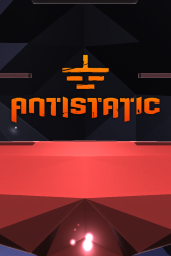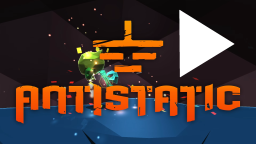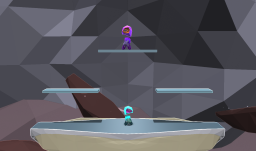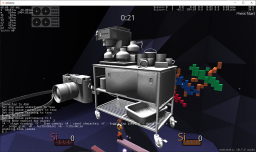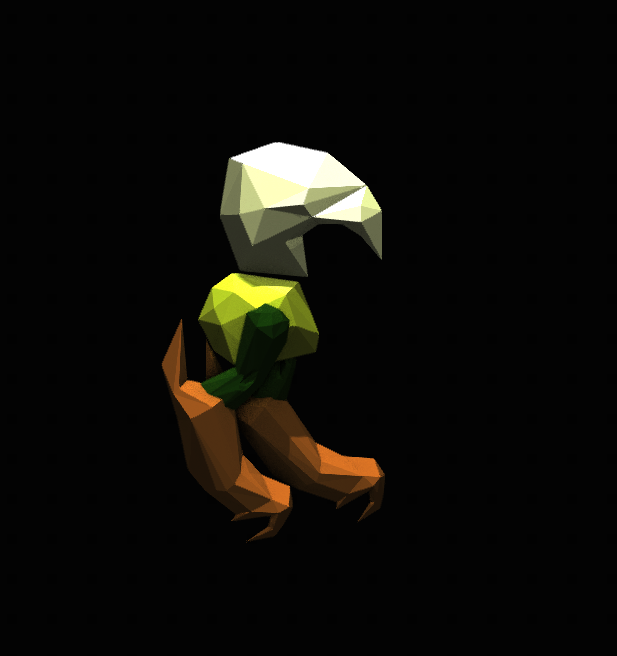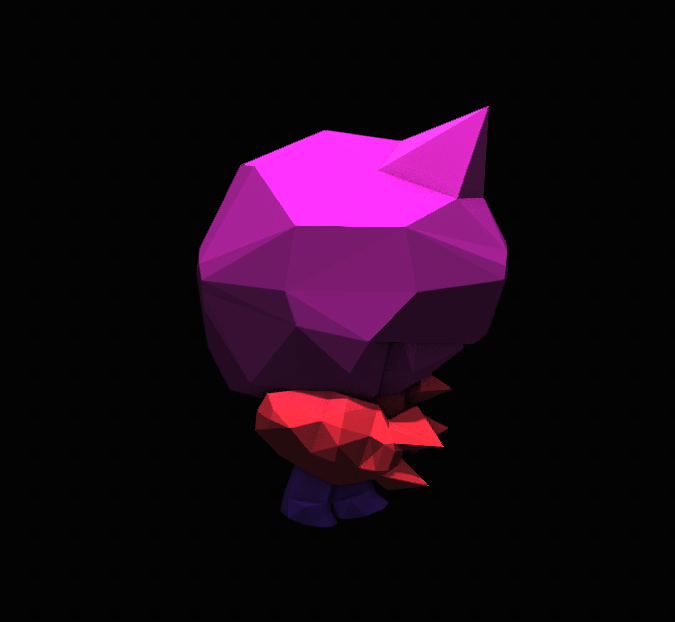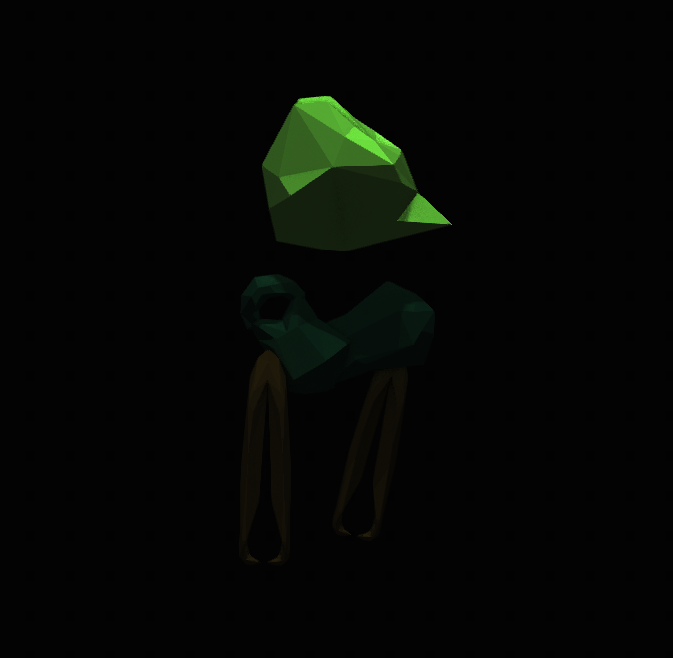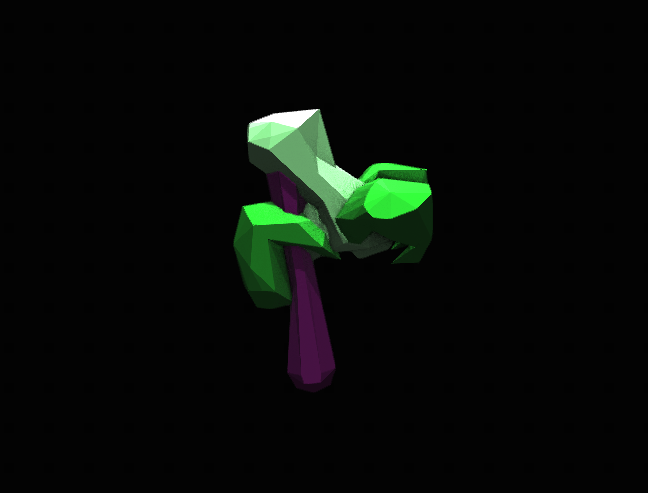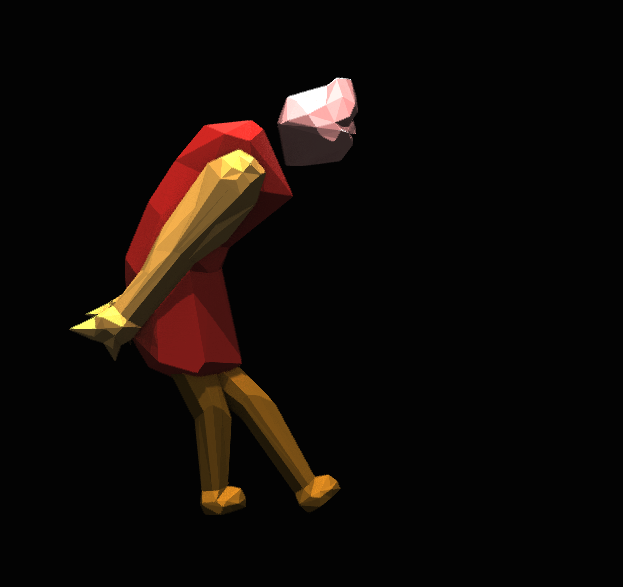Antistatic
v0.7.5 alpha // v0.8.0 testing
Antistatic is a crisp,
uncompromising platform fighter focused on exploring competitive
mechanics. Built, animated, and designed by a solo developer, in a
bespoke, custom engine.
Inside a crumbling digital world, atomic combatants carry out their
programming in an endless series of battles over the remaining
shielded landmarks.
Get the Game
-
Steam
-
itch.io
-
Humble Bundle
Community
-
Discord
-
Reddit
-
Roadmap (Trello)
Characters
Silicon
Mobile fastfaller with a lot of combo setups, but often lacks KO
power. Can apply pressure with lasers.
Carbon
High ground movement speed, powerful aerials.
Iron
Combo-focused heavyweight.
Xenon
Weird, complicated character; double jump cancels, lots of
mechanics.
Helium
High air speed, initial dash is faster than run speed; has multiple
air jumps
Rhodium
Disjointed moves with limitations. Normal moves must be refreshed
with down-special.
Silicon
Advice
-
Space with fair, bair, jab, lasers can be used to apply pressure
-
KO with bair, nair, forward-tap, up-tilt, tipper up-tap,
sweetspot ftilt
-
Late KO with ftilt, up air, forward throw, down-tap, up-tap
-
Combo with Pulse, down tilt, down throw, up throw, up tilt, jab
1/2, dair, up air, late hit neutral air
- Pulse semi-reliably combos into grabs and moves
Up - Arc
- Always does two jumps
- Jumps based on angle and tilt of control stick
Side - Trace
- Pseudojump
- Can be angled up/side/down
-
Applies a status that hits several times after a short delay
-
If shield is activated during status, all hits trigger
instantly and can be powershielded
Down - Pulse
- Frame 1 hit w/ intangibility
- Jump-canceleble on frame 4
- Can turn around during animation
Neutral - Emit
-
Projectile that can be land-canceled, does little damage but
causes flinching
Carbon
Advice
- Space with bair, nair, fair, dtilt, Bash
-
KO with tipper fair, tipper up air, second hit up air, dair,
up-tap, down-tap, super Bash
- KO late with down tilt, bair, forward-tap, Slice
-
combo with first hit up air, down tilt, forward throw, up throw,
reverse bair, first hit nair
Up - Slice
- Quick upwards burst
- Reversible
-
Can go vertically, or a little diagonally if holding forward
-
If backward is held at the end of the animation, character
will turn around
Side - Slam
- Can grab ledge during very start of fall
- Replenishes double jump
- Can be tilted forward/back
Down - Bash
-
After successfully hitting twice, or two targets at once, the
next use will be a more powerful version
Neutral - Fan
- Rapidly throw out several hits, fanned vertically
- Decent shield pressure
Iron
Advice
- Space with bair, uair, jab, utilt, Spring
- Cross-up with nair
- Combo with up air, up tilt, dair, forward throw, bair
- KO with fair, nair, ftilt, dtilt, f-tap, u-tap
- Late KO with nair, uair, f-tap, u-tap, up throw, Clobber
- Second-hit up air is semi-spike
Up - Grindstone
- On ground, can slide around during animation
-
In air, trajectory depends on direction of control stick
(up/forward/back/down/neutral)
Side - Spring
- Pseudojump
- Can be angled up/down
- Hurtbox extends before hitbox
Down - Clobber
- Two fast hits
-
Pushes forward, and can turn around mid-animation for the
second hit
Neutral - Bear Trap
- Hold to become a trap, release to attack
-
Gives small upward boost when attacking, but ends in free fall
- Can grab ledge
Xenon
Advice
- Space with fair, dtilt, nair, Orb
-
Combo with up air, dair, bair, up tilt, normal up-tap, tipper
fair (low percents), up throw, first hit nair
- KO with tipper fair, variant f-tap, f-tap, ftilt
-
KO late with sourspot fair, variant down-tap, variant up-tap, up
air, normal down-tap
- Down tilt is a set-knockback semi-spike
- Flash hitbox is also a set-knockback semi-spike
- Back air hits at a few different angles
- Down throw can lead into a tech chase
Double jump
- Can instant land at the start
-
Loses momentum at the end of the animation, so can gain extra
height by using a move at the right time to cancel it
- Can turn around with jump, and grab ledge
-
Has strong armor for a few frames at the start of the
animation
Specials
Up - Flash
- Can be canceled with shield before the jump
- Can grab ledge during animation
- Reduces gravity slightly
Side - Orb
- Shoots a slow projectile
- Projectile can be angled up or down
-
If projectile is out, using move again will teleport to the
projectile
- Projectile bounces off of shields and the stage
-
Projectile can be destroyed if attacked by a strong enough
move
Down - Alternate
-
Builds charges (up to 6) for variant tap attacks, adding a
charge creates a hitbox
- Can be canceled with shield
-
When there is a charge available for variant tap attacks, all
tap attacks get replaced with slightly different moves (WIP on
exact moves)
Neutral - Compress
-
When uncharged, gives short burst (4 frames) of strong armor
-
When charged, maintains strong armor for 4 seconds, can be
canceled into Orb, shield, jumps, or ended with shield hard
press in air
Helium
Advice
- Space with fair, bair, nair, forward-tap
-
Combo with dair, up air, late nair, d-tilt, f-tilt, dash attack
- KO with bair, nair 2, d-tap, gimps, f-tap
- Late KO with utilt, second hit uair, f-tap
-
Nair has an optional second hit if A is pressed at the end of
the animation
-
Up throw leaves open to counter attacks, but does massive damage
-
Back hit of up air always pulls forward, can be used to drag off
stage
- Charging f-tap will slide forward further
- Utilt has a spike at the end of its animation
- Jab is a spike
- First hit of dash attack is a spike
Up - Inflate
- Consumes double jumps, can be triggered multiple times
- Reversible
- Slightly better recovery per jump than normal air jumps
Side - Spark
- Pseudojump
-
Multi-hit; first hit triggers behind and can be used as a
single hit
- Holding special will prolong the attack
Down - Swoop
- Bounces back on hit with significantly less lag
Neutral - Seek
-
Hits where the control stick is pointing when the hitbox comes
out
Rhodium
Refresh and Burn
Every normal move (taps, tilts, aerials, grabs, throws) has some
hitbubbles that only activate while it's refreshed. Using a move
burns it. All moves are restored whenever Refresh (down-special)
is used. Many attacks gain a sweetspot or additional range, like
forward-tap or grabs. Some take on new trajectories, like throws.
Each time a move is burned (once per animation between refreshes),
the burn counter increases by 1, which is used by Burn
(neutral-special). Using Refresh fully resets this counter. A
consequence of animations is that moves spanning multiple
animations, like forward tilt (e.g. ftilt -> ftilt-up) or tap
attacks (f-tap -> charge -> release), count multiple times and can
be exploited to quickly reach a given number.
Up - Loop Slash
- Quickly curve backward and up
Side - Memory
-
Perform a hit in place, then quickly attack horizontally
-
If attack lands, or an attack hit shortly before activation,
then Rhodium remembers and moves toward that target
-
If the horizontal leap connects, then Rhodium may act after
the move; otherwise, become helpless
-
Tip: Immediately using side-B after connecting with fast move,
like nair, to home in for a follow up
Down - Refresh
-
Rhodium's primary mechanic: using down-B refreshes every
normal move
-
Can be jumped out of start on frame 4, and is intangible on
frame 1
-
If no moves have been burned, has a frame 1 hit with weak
knockback and horizontal trajectory
-
Tip: Can double-Refresh to get out a hit even if moves have
been burned; Refresh -> Jump -> Refresh before leaving ground
(3-frame window; frame 4-6)
-
See
Refresh and Burn section
Neutral - Burn
-
See
Refresh and Burn section
-
Shakes as it adds to the burn counter, until a move condition
is met
- Divisible by 5: Kick
- Divisible by 9: Spin
- Divisible by 13: Back Stab
Mechanics
-
Online play — join one other player in online
matches; online is still early in development, with much more in the
works
-
Familiar mechanics — shields, directional
influence, lag-canceling, grabs, wavedashing, and more
-
Full GameCube controller support — play with
the iconic platform fighter controller using the official adapter
-
6 characters — all with different play
styles, and more planned
-
10 stage layouts — some staples, and some new
Comparisons to a familiar game
Uncompromising, in Antistatic's case, describes a commitment to
building on familiar mechanics. If it's in Melee, it's probably
here. For peace of mind, though, here's most of what to expect:
- Lag-canceling: 66% landing lag
- Wave dashing; air dodges send into free fall
- Moonwalking, charlie walking
- Ledge mechanics, including 100%+ animations
- DI/SDI/ASDI
- Grabs, throws
- Teching
- Shields, light shields, shield dropping
- Wall jumps
-
Powershield, parry (see the guide below)
- V-canceling
- Crouch canceling (nerfed), ASDI down
- Aerials, charge moves, tilts, etc
Some new mechanics include:
-
Energy system: shields, specials, and holds consume energy; no
more mashing
-
Stale DI: certain moves that hit upward (up throws, etc) can be
DIed further sideways as they become more stale
-
Shield stun tweaked: lasts longer, but heavy shield stun
transitions into light shield stun, which allows rolls and dodges
Guide
Energy
The biggest new feature is the Energy meter.
Shields, specials, lag-canceling, and holding opponents all consume
Energy.
Each character has the same energy pool and regeneration speed. The
last chunk of used energy, the ligher chunk on the meter,
regenerates more quickly; it can help to space out big specials and
avoid lag-canceling or using shield immediately after for the
fastest regeneration potential.
Familiar
-
Lag-canceling: 50% landing lag, rounded up, plus one frame; costs
energy to perform based on move's landing lag
- Wave dashing; air dodges send into free fall
- Moonwalking, charlie walking
-
Ledge mechanics, including right-stick options and 100%+
animations
- DI/SDI/ASDI
- Grabs, throws
- Teching (wall, ground, ceiling)
-
Shields, light shields, shield dropping, 20XXTE-style Axe method
support, command shield drop if control stick is down and Special
(B) is pressed
- Wall jumping
- Powershield, parry (see differences)
-
All throws can be buffered with right-stick (not just down throw)
- Shield options can be buffered with right-stick
- V-canceling
- Throws use a set weight
- Crouch canceling (nerfed)
Differences
-
Reverse aerial rush possible during initial dash, but not during
run
- Initial dash can be canceled on first two frames
-
Most specials require energy to use, based on the amount of impact
they have
-
Holding consumes energy, grabs cannot be mashed out of; pummeling
accelerates energy use
-
Certain moves that hit upward (up throws, etc) can be DIed further
sideways as they become more stale
-
Ledge invincibility begins later the more times the ledge is
regrabbed; always ends on the same frame
- If grabs collide, they will cancel out
-
If a grab trades with an attack, grab is released if hit is above
a knockback threshold
- Powershield window is shorter
-
Powershield still takes heavy shield stun but removes light stun,
and consumes no energy
-
Parry window after releasing shield: only provides enhanced super
armor; take damage, but suffer no hit stun
- Powershield and parry both negate projectiles
-
If hit during first few frames of a double jump, jump will be
refreshed
-
Dodge panic: pressing grab (Z) during air dodge will cancel
movement into a stall that can grab ledge after a delay
Shields and Energy
- Powered by energy meter
- More HP
- Regenerate slower
-
When shield breaks, character crumples and falls to the ground
-
Shield stun has two phases: heavy (full) stun, and light stun
- During light shield stun, character can spot dodge and roll
-
Lag-canceling can be performed regardless of how much energy is
available and will consume energy down to 0
- Specials cannot be used with insufficient available energy
-
Holding consumes energy, and will release when energy reaches 0
Controllers
Currently officially supports GameCube (via Wii U/Switch adapter in
native mode), 360/XB1 (and compatible), PS4, and keyboard
Button/key rebinding will be improved later in testing, as well as
support for more controllers (e.g. Mayflash in PC mode, Switch Pro)
To get GameCube controllers to work on Windows, Zadig can be used to
install a generic driver; see
Dolphin's guide
for detailed instructions. Mac/Linux seem to work without hassle.
If you can already use controllers in Dolphin, it should work in
Antistatic too. In the future, this process might be an automated
option
Control rebinding
Basic controller rebinding is available in the in-game controls menu,
but is early in development and only changes default controls.
Keyboard rebinding still needs a lot of work.
Advanced
Advanced control rebinding can be accessed through the console
(bound to `; close with escape,
ctrl+d, or enter with nothing
entered).
Basic help is provided by using mapping on its own:
Usage: mapping [controller ID]
Prints mapping for controller ID, as well as lists available button/axis actions
Usage: mapping [controller ID] bind [button/axis name] [button/axis action] [axis value (keyboard only)]
Binds button/axis to action for controller ID
Usage: mapping [controller ID] save
Saves current mapping as the default for controller's kind
Usage: mapping [controller ID] reset
Resets mapping to original values for controller's kind
Usage: mapping [controller ID] default
Resets mapping to current default for controller's kind
Usage: mapping list
Lists all default and saved mappings
Usage: mapping list [controller kind]
Lists all default and saved mappings for controller kind (e.g. standard, gcn_native)
See also: controller (all)
Lists active controllers; if all is specified, includes all connected controllers
Examples
Keyboard rebinding
Rebind the space bar to shield, and save as the default.
Note
that all keys are case-sensitive right now; letters should be
lowercase (e.g. w, not W), special keys
should be capitalized (e.g. RETURN), and numbers are
either e.g. A_0 (number row) or
KP_0 (number pad)
Press ` to open the console.
$ controller all # list out all controllers
0. keyboard: keyboard
$ mapping 0 bind SPACE shield
$ mapping 0 save # saves as the default keyboard layout
Saved mapping file
List of all SDL2 key names, until the rebinding UI is done...
RETURN
ESCAPE
BACKSPACE
TAB
SPACE
EXCLAIM
QUOTEDBL
HASH
PERCENT
DOLLAR
AMPERSAND
QUOTE
LEFTPAREN
RIGHTPAREN
ASTERISK
PLUS
COMMA
MINUS
PERIOD
SLASH
A_0
A_1
A_2
A_3
A_4
A_5
A_6
A_7
A_8
A_9
COLON
SEMICOLON
LESS
EQUALS
GREATER
QUESTION
AT
LEFTBRACKET
BACKSLASH
RIGHTBRACKET
CARET
UNDERSCORE
BACKQUOTE
a
b
c
d
e
f
g
h
i
j
k
l
m
n
o
p
q
r
s
t
u
v
w
x
y
z
CAPSLOCK
F1
F2
F3
F4
F5
F6
F7
F8
F9
F10
F11
F12
PRINTSCREEN
SCROLLLOCK
PAUSE
INSERT
HOME
PAGEUP
DELETE
END
PAGEDOWN
RIGHT
LEFT
DOWN
UP
NUMLOCKCLEAR
KP_DIVIDE
KP_MULTIPLY
KP_MINUS
KP_PLUS
KP_ENTER
KP_1
KP_2
KP_3
KP_4
KP_5
KP_6
KP_7
KP_8
KP_9
KP_0
KP_PERIOD
APPLICATION
POWER
KP_EQUALS
F13
F14
F15
F16
F17
F18
F19
F20
F21
F22
F23
F24
EXECUTE
HELP
MENU
SELECT
STOP
AGAIN
UNDO
CUT
COPY
PASTE
FIND
MUTE
VOLUMEUP
VOLUMEDOWN
KP_COMMA
KP_EQUALSAS400
ALTERASE
SYSREQ
CANCEL
CLEAR
PRIOR
RETURN2
SEPARATOR
OUT
OPER
CLEARAGAIN
CRSEL
EXSEL
KP_00
KP_000
THOUSANDSSEPARATOR
DECIMALSEPARATOR
CURRENCYUNIT
CURRENCYSUBUNIT
KP_LEFTPAREN
KP_RIGHTPAREN
KP_LEFTBRACE
KP_RIGHTBRACE
KP_TAB
KP_BACKSPACE
KP_A
KP_B
KP_C
KP_D
KP_E
KP_F
KP_XOR
KP_POWER
KP_PERCENT
KP_LESS
KP_GREATER
KP_AMPERSAND
KP_DBLAMPERSAND
KP_VERTICALBAR
KP_DBLVERTICALBAR
KP_COLON
KP_HASH
KP_SPACE
KP_AT
KP_EXCLAM
KP_MEMSTORE
KP_MEMRECALL
KP_MEMCLEAR
KP_MEMADD
KP_MEMSUBTRACT
KP_MEMMULTIPLY
KP_MEMDIVIDE
KP_PLUSMINUS
KP_CLEAR
KP_CLEARENTRY
KP_BINARY
KP_OCTAL
KP_DECIMAL
KP_HEXADECIMAL
LCTRL
LSHIFT
LALT
LGUI
RCTRL
RSHIFT
RALT
RGUI
MODE
AUDIONEXT
AUDIOPREV
AUDIOSTOP
AUDIOPLAY
AUDIOMUTE
MEDIASELECT
WWW
MAIL
CALCULATOR
COMPUTER
AC_SEARCH
AC_HOME
AC_BACK
AC_FORWARD
AC_STOP
AC_REFRESH
AC_BOOKMARKS
BRIGHTNESSDOWN
BRIGHTNESSUP
DISPLAYSWITCH
KBDILLUMTOGGLE
KBDILLUMDOWN
KBDILLUMUP
EJECT
SLEEP
APP1
APP2
AUDIOREWIND
AUDIOFASTFORWARD
XInput (e.g. XB1): rebind X to jump, B to special
Press ` to open the console.
$ controller all # list out all controllers
0. keyboard: keyboard
1. XInput Controller: standard
$ mapping 1
A attack
B jump
...
$ mapping 1 bind X jump
$ mapping 1 bind B special
$ mapping 1 save
Saved mapping file
Reset all saved mappings to original
Option 1, using rm
Press ` to open the console.
$ rm ~/mapping/standard.default
Option 2, also reset controller
Press ` to open the console.
$ controller all # list out all controllers
0. keyboard: keyboard
1. XInput Controller: standard
$ mapping 1 reset
Reset mapping
$ mapping 1 save
Saved mapping file
Technical Summary
Antistatic has been in development since 2012 as an experimental
homage to Super Smash Bros. Melee. It is built in a custom engine,
written in TypeScript and C, with a 3D OpenGL graphics engine.
Antistatic runs on top of Node.js, with the bulk written in
TypeScript. Native portions are written in C, and run as a Node.js
addon.
Tech Stack
- Main language: TypeScript
- Native code: C
- Server language: Go
- Server OS: Ubuntu
- Graphics: OpenGL
- Shaders: GLES
- Fully from-scratch graphics
- Custom physics engine
- Uncapped player count
- Latency-optimized rendering and input processing
- Font atlassing in C
- Delay-based P2P UDP netcode
- Custom build system: Bash, PowerShell
Open-Source Pieces
-
Lobby server:
antistatic-server
-
Input state machine:
capacitor
-
Color math scripting language:
trace
-
Loader:
antistatic-loader
-
Animator:
antistatic-animator
-
Translations:
antistatic-translations
-
Easing library:
@bluehexagons/easing
All Third-Party Dependencies
-
Runtime: Node.js
-
Window: SDL2
- Gamepads: SDL2
-
Fonts:
Freetype
-
USB:
LibUSB
-
Audio:
OpenAL-soft
-
Container/codec:
Ogg/Vorbis
-
Internationalization:
Fluent
-
Source control:
git
-
GLEW
-
stb
-
node-bindings
-
gl-matrix
-
intl
-
jsonc-parser
-
open
-
os-locale
-
node-segfault-handler
Even More Technical Details
Antistatic's matchmaking server is built in Go
and is open-source. I run it as a service on a headless Ubuntu server that I
maintain, hosted by a popular VPS.
Graphics engine
The graphics engine is also split, with lower-level code written in
C and OpenGL and much of the model manipulation, vertex rendering,
and animation written in TypeScript. FreeType is used to render a
dynamically-growing font atlas. Other libraries used include: GLEW
for OpenGL bindings, SDL2 for window management, and SDL2_image for
image loading.
Audio engine
The audio engine uses OpenAL-soft to interface with hardware. Files
are OGGs, and libvorbistools is used to decode them.
Netcode
Netcode is peer-to-peer and delay-based, and some infrastructure
work has been done to move toward adding rollback in the future. It
runs on UDP, with higher-level messages encoded in JSON along with a
binary stream of controller snapshots. The engine attempts to
synchronize beginning times and input delay, poke through permissive
firewalls, and gracefully handle dropped packets.
USB GCN Controller Adapter Support
To connect to the official Wii U/Switch GameCube controller adapter,
I used LibUSB to directly communicate with the adapter over USB.
Internationalization
Internationalization is handled using Fluent, with the language
files
available on GitHub. Currently, only English and Spanish have had human review.
Build system
Antistatic's build system is mostly automated starting from a
build-free git repo, pulling in and installing dependencies as well
as building a few binaries. The process is a mix of PowerShell and
Bash scripts.
History
Originally, Antistatic ran in a web browser. The limitations started
adding up, and I made the decision to move to Electron and add a
native add-on. When I couldn't squeeze the consistent performance
and hardware support I felt I needed, I re-implemented more pieces
in C and moved onto Node.js directly.
